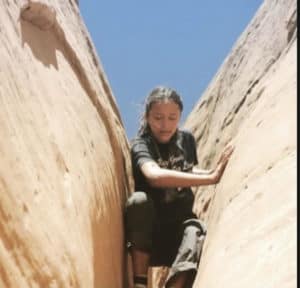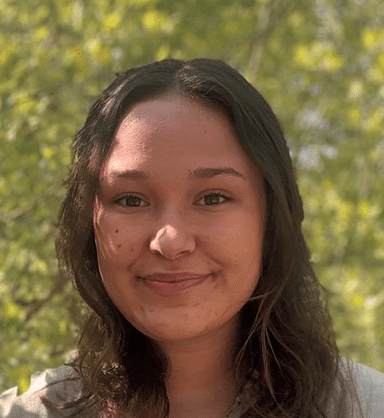Mia Jespersen-Chavez was introduced to the Gulch through day trips with her elementary school before trekking on the Outfit in 2014 and the Wild Country Trek in 2016. Now a senior in high school, she volunteers at the Bachechi Center in Albuquerque’s North Valley where she develops curriculums for young kids that will give them tools to have enriching experiences in the outdoors. What sticks with her from the Gulch is being given the freedom to learn independently and face her own challenges, and she wants others to have that same opportunity to grow.
The freedom Mia felt while on trek provided opportunities for serendipitous fun and the forging of close bonds. This was obvious in traditions like the Peach Toss but she also found it in the more tedious moments. A few painfully long van rides are inevitable during the summer and Mia cherished this time when she could learn more about her groupmates. Outside the Gulch “it’s all about technology, what game you can play on your phone, what movie you’re going to watch on this trip, but you don’t have that and you’re honestly really thankful because you interact with people in a way that you would never see yourself doing.”
Beyond the time devoted to wholesome fun, Mia loved how her staff gave trekkers the autonomy to find their own challenges and learn for themselves. This clicked for her during “solos”, when her leaders would place each trekker in a remote spot around their campsite and give them several hours by themselves. Afterwards, they would return to the group and share what had worked or reflected on. This luxury of time Mia found at the Gulch is something she has come to value: “it gives you the opportunity to question things on your own, [and] you get the building blocks to figure things out.”

Mia in WCT
Mia also appreciated seeing her peers grow during their expeditions. “On my treks I’ve been with people who weren’t even the biggest fans of camping, but then they walk away super ecstatic to go home and teach people what they learned.” While one trekker’s challenge might be learning to overcome their homesickness, another’s will be learning how to channel their energy to support the group. As Mia put it, the experience “gives you power– and everyone is going to take away a different experience than everyone else, which is pretty magical.” She would encourage anyone to trek, because you can’t know exactly what you’ll get out of it–apart from a group of really close friends.
The experiential learning framework that Mia found at the Gulch has served her well in her work at the Bachechi Center. There she and staff Marnie Rehn are developing a curriculum to give young kids and their parents the tools to better take advantage of the outdoors as a place for learning and recreation. At the moment, the cohort is focused on engaging the five senses to discover new dimensions of the outdoors. Mia is also looking forward to working with underserved eighth graders as part of Gulch’s Students in Wilderness Initiative. Next year, she plans to attend college somewhere in the Pacific Northwest, where she wants to pursue studying outdoor education. Still, she’s careful to stay open-minded.
What has made the Gulch special to Mia is the people she encounters here. She is always grateful to learn about perspectives of trekkers and staff from other places and with different life experiences, and to bond with them in serious and silly moments. For her, giving to the Gulch is giving others the same opportunity to be part of the diverse and welcoming community that she found.

